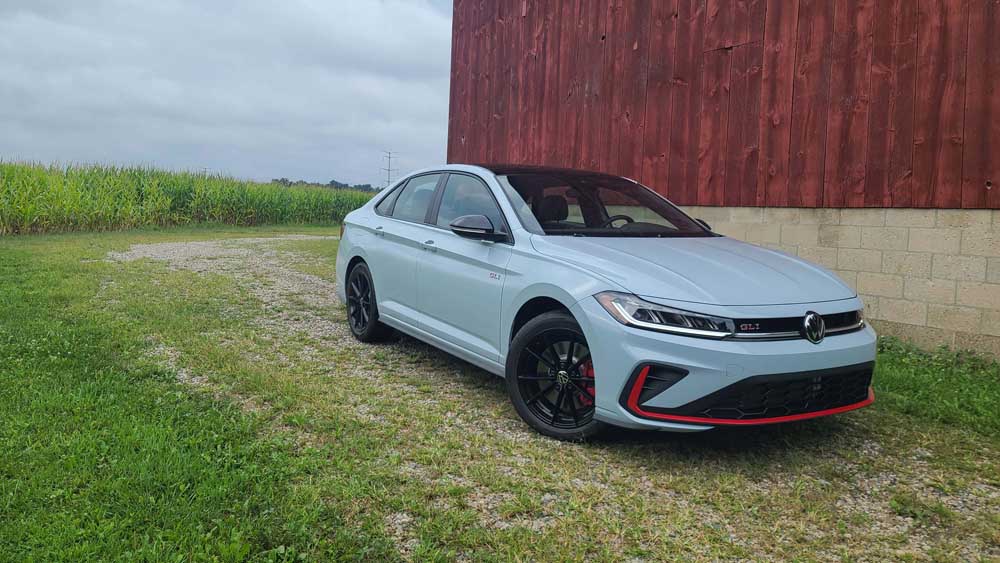Cars have become computers, but some want old-school transmissions back
Published 5:12 pm Sunday, October 27, 2024

- With a leaner, more sculpted front and rear fascia — and dressed in Montery Blue Pearl — the 2025 Volkswagen Jetta GLI is a looker.
It’s high noon on the winding Angeles Crest Highway outside L.A., and Dario Franchitti is dancing on the aluminum pedals of a $3 million supercar. He’s spent this August morning on the serpentine switchbacks, shifting his way to triple-digit velocity.
We’re in a Gordon Murray T.50, a lightweight rocket ship with three seats that’s being produced in a limited run of 100. It’s an insane car, but the most interesting thing isn’t its seating arrangement, nor its eponymous creator, the South African engineer who designed the McLaren F1.
Unveiled in 2021, the T.50 has a gearbox that Franchitti is shifting manually. The car was at the forefront of a revolt against the automatic SUVs, paddle-shift coupes and gearless electric vehicles that dominate roads. Even as the shifters in sports cars have disappeared, a class of consumers is asking for something their parents took for granted: a manual transmission.
Established automakers and newcomers alike in the past year have rolled out models designed to recapture a visceral connection to driving. Monterey Car Week, an annual automotive orgy in August, was full of them.
Pagani SpA revealed a six-speed transmission in its $3.4 million Utopia roadster; Tuthill Porsche introduced the GT One, a version of Porsche’s 911 GT1 that offers a six-speed manual setup. Aston Martin Lagonda’s $2 million Valour, released in July, likewise pairs a six-speed transmission with its 705-horsepower engine.
“This is a high-wire act,” Franchitti says as he downshifts into a curve, expertly timing the release of the clutch. “I gravitate toward more analog cars because of the driving experience. I just love it.”
When the first motorized carriages emerged before 1900, operators had to physically sync the speed of the engine to the appropriate gear of the axle turning the wheels.
As the years passed, powerful Bentley Blowers, family sedans and sports coupes all used this manual system of shifting.
In the late 1920s, Maybach was making semiautomatic, smooth and powerful transmissions for its stately Zeppelins; by the end of the next decade, General Motors Co. introduced fully automatic transmissions in the U.S. By the 1940s and ’50s, everyone else started using them to make driving easier.
Today, only 2% of new vehicles sold in the U.S. have manual transmissions, per data from CarMax. Most manufacturers, even famous sports car brands such as Ferrari NV and Automobili Lamborghini SpA, don’t make them at all anymore.
“There are a small group always asking for manual transmissions,” says Stephan Winkelmann, president and chief -executive officer of Lamborghini. “But we are focusing on bigger opportunities.”
A few loyalists can be found across the price spectrum. Jeep offers one in its Wrangler and Gladiator. Porsche AG makes a six-speed one for some of its 718s and 911s. Mazda Motor Corp. reports a healthy 60% take rate on its manual MX-5. “I suppose just like gentlemen prefer blondes, gentlemen prefer a manual,” says Ian Scott Dorey, a hair and fashion stylist based in Los Angeles. He’s on his fourth Mazda Miata stick shift. “My car is made for ultimate maneuverability in all situations, and the stick is a part of that,” he says. “There’s just something about slamming the pedal and taking off in a burst of speed.”
Subaru makes two models with a manual transmission. For 2024 through August, 79% of BRZ and 87% of WRX sales have been manuals, a spokesperson says. Todd Templeman, a Portland, Oregon-based photographer, has been shifting his 2013 Subaru WRX STI GR for a decade. For him, it’s about sensory pleasures-the sound of the engine revving, the feel of clutch under his foot, the wind running through his mullet from the open window as he rows through gears. “A perfect rev-match downshift before a corner is one of the best feelings in the world,” he says.
But these adherents remain oddities. Enrico Galliera, Ferrari’s chief marketing and commercial officer, says it offered manual gearboxes up until the California: “The take rate was 0.001%.”
Mark Reuss, president of GM, says implementing a stick shift creates costs that stretch across the model line and are too high to justify. “Adding a manual is just a bridge too far,” he says. The last manual Corvette came out in 2019.
It stands to reason most people would prefer a vehicle to shift for itself. An automatic is faster and more precise, and anyone who’s met a stoplight on a steep hill or worked through traffic with a heavy clutch and a throbbing left quad knows manual gearboxes can engender anxiety, fatigue and, when done poorly, mechanical headaches and expenses.
“Customers that desire a manual car are driving enthusiasts,” says Alex Long, director of product strategy at Aston Martin. And that enthusiasm comes with bragging rights. Early manuals were hot and heavy; a misplaced shift could blow the engine or burn through the clutch. Mastering it meant you were worthy of such a glorious machine.






